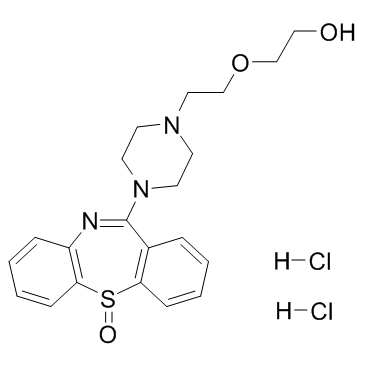
| 规格 | 价格 | 库存 | 数量 |
|---|---|---|---|
| 1mg |
|
||
| Other Sizes |
|

| 靶点 |
Major metabolite of Quetiapine
|
|---|---|
| 体内研究 (In Vivo) |
喹硫平亚砜的估计 Cmax 值为 77.3 ± 32.4 ng/mL(平均值 ± SD)。对于喹硫平亚砜,计算出的 AUClast 值为 1,286±458 ng·h/mL。喹硫平亚砜的代谢率随着时间的推移而下降,用药后 72 小时后平均代谢率下降 30%,而 2 小时内平均代谢率下降 119% [1]。
|
| 参考文献 |
|
| 其他信息 |
Background and purpose: Quetiapine has a range of clinical activity distinct from other atypical antipsychotic drugs, demonstrating efficacy as monotherapy in bipolar depression, major depressive disorder and generalized anxiety disorder. The neuropharmacological mechanisms underlying this clinical profile are not completely understood; however, the major active metabolite, norquetiapine, has been shown to have a distinct in vitro pharmacological profile consistent with a broad therapeutic range and may contribute to the clinical profile of quetiapine.
Experimental approach: We evaluated quetiapine and norquetiapine, using in vitro binding and functional assays of targets known to be associated with antidepressant and anxiolytic drug actions and compared these activities with a representative range of established antipsychotics and antidepressants. To determine how the in vitro pharmacological properties translate into in vivo activity, we used preclinical animal models with translational relevance to established antidepressant-like and anxiolytic-like drug action.
Key results: Norquetiapine had equivalent activity to established antidepressants at the noradrenaline transporter (NET), while quetiapine was inactive. Norquetiapine was active in the mouse forced swimming and rat learned helplessness tests. In in vivo receptor occupancy studies, norquetiapine had significant occupancy at NET at behaviourally relevant doses. Both quetiapine and norquetiapine were agonists at 5-HT1A receptors, and the anxiolytic-like activity of norquetiapine in rat punished responding was blocked by the 5-HT1A antagonist, WAY100635.
Conclusions and implications: Quetiapine and norquetiapine have multiple in vitro pharmacological actions, and results from preclinical studies suggest that activity at NET and 5-HT1A receptors contributes to the antidepressant and anxiolytic effects in patients treated with quetiapine. [1]
Risperidone, paliperidone, quetiapine, olanzapine, and aripiprazole are antipsychotic drugs approved for treating various psychiatric disorders, including schizophrenia. The objective of this randomized, parallel-group, open-label study was to compare finger-stick-based capillary with corresponding venous whole-blood and plasma concentrations for these drugs after administration of a single dose to healthy volunteers. All whole-blood and plasma drug concentrations were measured with validated liquid chromatography-tandem mass spectrometry methods. Capillary and venous concentrations (both in plasma and whole blood) were in close agreement, although a time-dependent difference was observed, most obviously for olanzapine and paliperidone, with slightly higher capillary versus venous drug concentrations during the first hours after administering a single dose. The observed difference between capillary and venous plasma drug concentrations is expected not to be relevant in clinical practice, considering the wide window of therapeutic concentrations and the wide range of drug concentrations in the patient population for a given dose. Based on these results, finger-stick-based capillary drug concentrations have been shown to approximate venous drug concentrations.[2] |
| 分子式 |
C21H27CL2N3O3S
|
|---|---|
| 分子量 |
472.428382158279
|
| 精确质量 |
471.115
|
| CAS号 |
329218-11-3
|
| 相关CAS号 |
Quetiapine;111974-69-7;Quetiapine hemifumarate;111974-72-2;Quetiapine sulfoxide;329216-63-9;Quetiapine sulfoxide hydrochloride;2448341-72-6
|
| PubChem CID |
45358163
|
| 外观&性状 |
White to yellow solid powder
|
| LogP |
3.652
|
| tPSA |
84.58
|
| 氢键供体(HBD)数目 |
3
|
| 氢键受体(HBA)数目 |
7
|
| 可旋转键数目(RBC) |
6
|
| 重原子数目 |
30
|
| 分子复杂度/Complexity |
515
|
| 定义原子立体中心数目 |
0
|
| InChi Key |
MPRQQJUQOLNAFP-UHFFFAOYSA-N
|
| InChi Code |
InChI=1S/C21H25N3O3S.2ClH/c25-14-16-27-15-13-23-9-11-24(12-10-23)21-17-5-1-3-7-19(17)28(26)20-8-4-2-6-18(20)22-21;;/h1-8,25H,9-16H2;2*1H
|
| 化学名 |
2-[2-[4-(11-oxobenzo[b][1,4]benzothiazepin-6-yl)piperazin-1-yl]ethoxy]ethanol;dihydrochloride
|
| 别名 |
329218-11-3; Quetiapine sulfoxide (dihydrochloride); Quetiapine Sulfoxide Dihydrochloride; Ethanol, 2-[2-[4-(5-oxidodibenzo[b,f][1,4]thiazepin-11-yl)-1-piperazinyl]ethoxy]- ,dihydrochloride; Quetiapine S-oxide dihydrochloride; 2-[2-[4-(11-oxobenzo[b][1,4]benzothiazepin-6-yl)piperazin-1-yl]ethoxy]ethanol;dihydrochloride; ETHANOL,2-[2-[4-(5-OXIDODIBENZO[B,F][1,4]THIAZEPIN-11-YL)-1-PIPERAZINYL]ETHOXY]-,DIHYDROCHLORIDE;
|
| HS Tariff Code |
2934.99.9001
|
| 存储方式 |
Powder -20°C 3 years 4°C 2 years In solvent -80°C 6 months -20°C 1 month 注意: 请将本产品存放在密封且受保护的环境中,避免吸湿/受潮。 |
| 运输条件 |
Room temperature (This product is stable at ambient temperature for a few days during ordinary shipping and time spent in Customs)
|
| 溶解度 (体外实验) |
H2O : ~250 mg/mL (~529.18 mM)
|
|---|---|
| 溶解度 (体内实验) |
配方 1 中的溶解度: 50 mg/mL (105.84 mM) in PBS (这些助溶剂从左到右依次添加,逐一添加), 澄清溶液; 超声助溶。
请根据您的实验动物和给药方式选择适当的溶解配方/方案: 1、请先配制澄清的储备液(如:用DMSO配置50 或 100 mg/mL母液(储备液)); 2、取适量母液,按从左到右的顺序依次添加助溶剂,澄清后再加入下一助溶剂。以 下列配方为例说明 (注意此配方只用于说明,并不一定代表此产品 的实际溶解配方): 10% DMSO → 40% PEG300 → 5% Tween-80 → 45% ddH2O (或 saline); 假设最终工作液的体积为 1 mL, 浓度为5 mg/mL: 取 100 μL 50 mg/mL 的澄清 DMSO 储备液加到 400 μL PEG300 中,混合均匀/澄清;向上述体系中加入50 μL Tween-80,混合均匀/澄清;然后继续加入450 μL ddH2O (或 saline)定容至 1 mL; 3、溶剂前显示的百分比是指该溶剂在最终溶液/工作液中的体积所占比例; 4、 如产品在配制过程中出现沉淀/析出,可通过加热(≤50℃)或超声的方式助溶; 5、为保证最佳实验结果,工作液请现配现用! 6、如不确定怎么将母液配置成体内动物实验的工作液,请查看说明书或联系我们; 7、 以上所有助溶剂都可在 Invivochem.cn网站购买。 |
| 制备储备液 | 1 mg | 5 mg | 10 mg | |
| 1 mM | 2.1167 mL | 10.5836 mL | 21.1672 mL | |
| 5 mM | 0.4233 mL | 2.1167 mL | 4.2334 mL | |
| 10 mM | 0.2117 mL | 1.0584 mL | 2.1167 mL |
1、根据实验需要选择合适的溶剂配制储备液 (母液):对于大多数产品,InvivoChem推荐用DMSO配置母液 (比如:5、10、20mM或者10、20、50 mg/mL浓度),个别水溶性高的产品可直接溶于水。产品在DMSO 、水或其他溶剂中的具体溶解度详见上”溶解度 (体外)”部分;
2、如果您找不到您想要的溶解度信息,或者很难将产品溶解在溶液中,请联系我们;
3、建议使用下列计算器进行相关计算(摩尔浓度计算器、稀释计算器、分子量计算器、重组计算器等);
4、母液配好之后,将其分装到常规用量,并储存在-20°C或-80°C,尽量减少反复冻融循环。
计算结果:
工作液浓度: mg/mL;
DMSO母液配制方法: mg 药物溶于 μL DMSO溶液(母液浓度 mg/mL)。如该浓度超过该批次药物DMSO溶解度,请首先与我们联系。
体内配方配制方法:取 μL DMSO母液,加入 μL PEG300,混匀澄清后加入μL Tween 80,混匀澄清后加入 μL ddH2O,混匀澄清。
(1) 请确保溶液澄清之后,再加入下一种溶剂 (助溶剂) 。可利用涡旋、超声或水浴加热等方法助溶;
(2) 一定要按顺序加入溶剂 (助溶剂) 。